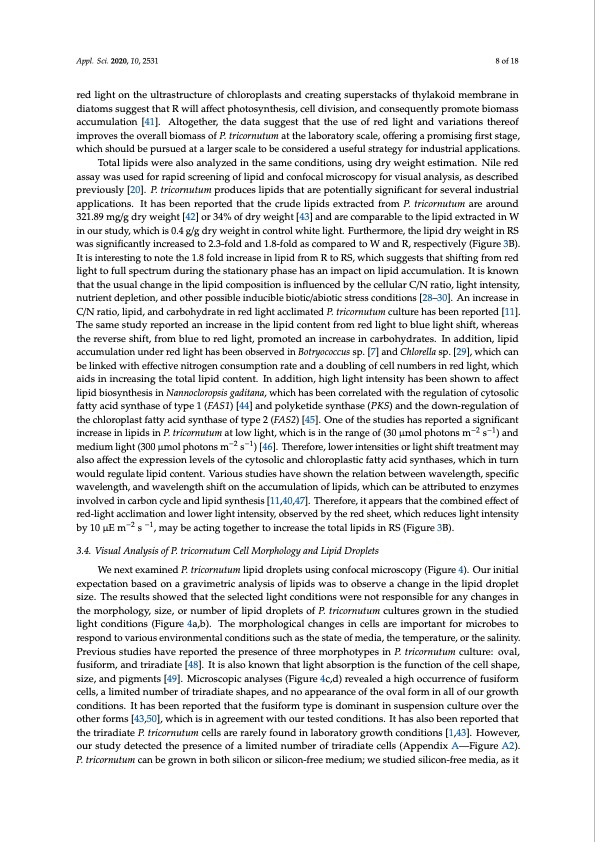
PDF Publication Title:
Text from PDF Page: 008
Appl. Sci. 2020, 10, 2531 8 of 18 red light on the ultrastructure of chloroplasts and creating superstacks of thylakoid membrane in diatoms suggest that R will affect photosynthesis, cell division, and consequently promote biomass accumulation [41]. Altogether, the data suggest that the use of red light and variations thereof improves the overall biomass of P. tricornutum at the laboratory scale, offering a promising first stage, which should be pursued at a larger scale to be considered a useful strategy for industrial applications. Total lipids were also analyzed in the same conditions, using dry weight estimation. Nile red assay was used for rapid screening of lipid and confocal microscopy for visual analysis, as described previously [20]. P. tricornutum produces lipids that are potentially significant for several industrial applications. It has been reported that the crude lipids extracted from P. tricornutum are around 321.89 mg/g dry weight [42] or 34% of dry weight [43] and are comparable to the lipid extracted in W in our study, which is 0.4 g/g dry weight in control white light. Furthermore, the lipid dry weight in RS was significantly increased to 2.3-fold and 1.8-fold as compared to W and R, respectively (Figure 3B). It is interesting to note the 1.8 fold increase in lipid from R to RS, which suggests that shifting from red light to full spectrum during the stationary phase has an impact on lipid accumulation. It is known that the usual change in the lipid composition is influenced by the cellular C/N ratio, light intensity, nutrient depletion, and other possible inducible biotic/abiotic stress conditions [28–30]. An increase in C/N ratio, lipid, and carbohydrate in red light acclimated P. tricornutum culture has been reported [11]. The same study reported an increase in the lipid content from red light to blue light shift, whereas the reverse shift, from blue to red light, promoted an increase in carbohydrates. In addition, lipid accumulation under red light has been observed in Botryococcus sp. [7] and Chlorella sp. [29], which can be linked with effective nitrogen consumption rate and a doubling of cell numbers in red light, which aids in increasing the total lipid content. In addition, high light intensity has been shown to affect lipid biosynthesis in Nannocloropsis gaditana, which has been correlated with the regulation of cytosolic fatty acid synthase of type 1 (FAS1) [44] and polyketide synthase (PKS) and the down-regulation of the chloroplast fatty acid synthase of type 2 (FAS2) [45]. One of the studies has reported a significant increase in lipids in P. tricornutum at low light, which is in the range of (30 μmol photons m−2 s−1) and medium light (300 μmol photons m−2 s−1) [46]. Therefore, lower intensities or light shift treatment may also affect the expression levels of the cytosolic and chloroplastic fatty acid synthases, which in turn would regulate lipid content. Various studies have shown the relation between wavelength, specific wavelength, and wavelength shift on the accumulation of lipids, which can be attributed to enzymes involved in carbon cycle and lipid synthesis [11,40,47]. Therefore, it appears that the combined effect of red-light acclimation and lower light intensity, observed by the red sheet, which reduces light intensity by 10 μE m−2 s −1, may be acting together to increase the total lipids in RS (Figure 3B). 3.4. Visual Analysis of P. tricornutum Cell Morphology and Lipid Droplets We next examined P. tricornutum lipid droplets using confocal microscopy (Figure 4). Our initial expectation based on a gravimetric analysis of lipids was to observe a change in the lipid droplet size. The results showed that the selected light conditions were not responsible for any changes in the morphology, size, or number of lipid droplets of P. tricornutum cultures grown in the studied light conditions (Figure 4a,b). The morphological changes in cells are important for microbes to respond to various environmental conditions such as the state of media, the temperature, or the salinity. Previous studies have reported the presence of three morphotypes in P. tricornutum culture: oval, fusiform, and triradiate [48]. It is also known that light absorption is the function of the cell shape, size, and pigments [49]. Microscopic analyses (Figure 4c,d) revealed a high occurrence of fusiform cells, a limited number of triradiate shapes, and no appearance of the oval form in all of our growth conditions. It has been reported that the fusiform type is dominant in suspension culture over the other forms [43,50], which is in agreement with our tested conditions. It has also been reported that the triradiate P. tricornutum cells are rarely found in laboratory growth conditions [1,43]. However, our study detected the presence of a limited number of triradiate cells (Appendix A—Figure A2). P. tricornutum can be grown in both silicon or silicon-free medium; we studied silicon-free media, as itPDF Image | Red Light Variation Lipid Profiles in Phaeodactylum tricornutum

PDF Search Title:
Red Light Variation Lipid Profiles in Phaeodactylum tricornutumOriginal File Name Searched:
applsci-10-02531.pdfDIY PDF Search: Google It | Yahoo | Bing
Cruise Ship Reviews | Luxury Resort | Jet | Yacht | and Travel Tech More Info
Cruising Review Topics and Articles More Info
Software based on Filemaker for the travel industry More Info
The Burgenstock Resort: Reviews on CruisingReview website... More Info
Resort Reviews: World Class resorts... More Info
The Riffelalp Resort: Reviews on CruisingReview website... More Info
| CONTACT TEL: 608-238-6001 Email: greg@cruisingreview.com | RSS | AMP |